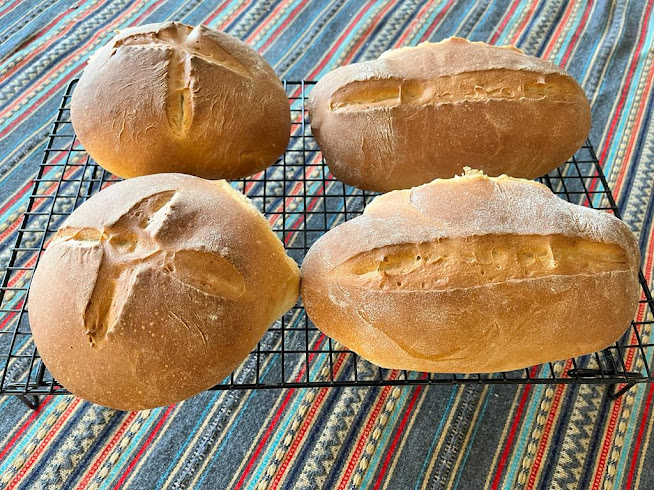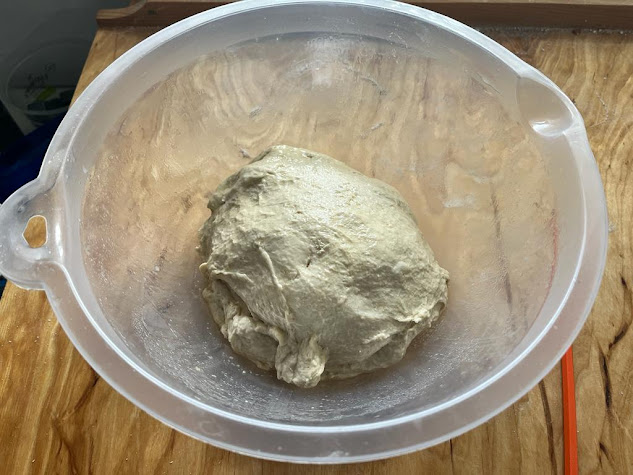Ciscaucasian Kefir Bread
What is Kefir?
It's a fermented milk product, similar to thin yoghurt that's made from kefir grains. The grains are a mesophilic symbiotic culture.
Kefir as a drink originated in the North Caucasus and has become a top-selling product in Russia and Poland.
Kefir is full of 'good bacteria' as well as minerals and vitamins. The best kefir is homegrown. I bought kefir grains from a whole food shop. Once acquired, they are mixed with full-cream milk and left in a warm place to ferment. After the milk has become lumpy and clearly fermented, it's strained and the milk used. The grains are then kept in the refrigerator until they are needed, when they are mixed with milk again and the cycle continues.
Why use it in bread?
The addition of Kefir along with a yeast leavening agent produces a wonderfully light and fluffy bread.
It adds both texture and taste. What more does any home baker want?
There are two ways to make Kefir Bread. The first is to use Kefir alongside a commercial yeast. The recipe I present today does exactly that. Why? Because it speeds up the process and you have fresh oven-baked bread within a reasonable timescale.
The second is to use Kefir not only to provide taste and texture but also as a fermentation tool. To do this, you need to first ferment the milk using the Kefir grains and then make up a pre-ferment using flour and Kefir. This is similar in process to using a preferment 'sponge'. Then, when that is active, add the sponge to the remaining ingredients, mix, knead and leave to ferment fully before carrying on the process.
But that's for another day.
Today...we're using a commercial yeast as a support mechanism for the fermentation and for the Kefir.
I've called this Ciscaucasian Kefir bread to acknowledge its origins...
INGREDIENTS
600 gms strong white bread flour
50 gms unsalted butter (softened)
10 gms crushed sea salt
30 gms dark brown sugar
20 gms fresh yeast OR 7 gms of active dried yeast OR 6 gms instant yeast
175 gms tepid water
175 gms fresh kefir milk
METHOD
Activating the yeast - in a small bowl, mix a little of the sugar and the water together and add either the fresh yeast or the dried yeast. Cover and leave for 10 minutes or until it is foaming.
If you are using instant yeast, move on to the next stage and add it to the flour.
1. In a bowl, add the kefir and the water and the sugar and the yeast mixture.
2. In a separate bowl, mix the flour with the salt.
3. Add the liquid mixture to the flour and then add the softened butter.
If you're using instant yeast, add it now.
4. Mix together and then knead for about 8 minutes until you have a soft, silky and smooth dough.
5. Place the dough in a lightly-oiled bowl, cover and leave in a warm place to double in volume.
6. Tip the dough out onto a lightly-floured board and gently 'knock it back'.
Knocking back: This is a technical term for punching or pressing down on the dough after the bread's first rise. This process bursts the tiny air bubbles that have formed in the dough and then forces them to reform again in the final shape you want, which results in a smoother texture.
7. Decide on whether you are making a large boule, a tin loaf, rolls or bloomers (batards). Divide the dough as required.
8. Shape the dough and place o a prepared baking sheet. Cover and return to a warm place for about 30 - 45 minutes to allow it to proof for a second time.
9. Preheat the oven to 190⁰C (375⁰F). Bake for about 30 minutes until the bread is golden and hollow when tapped on the underneath.
10. Cool on a rack.
Happy baking....







Cara menggugurkan kandungan , Cara menggugurkan kandungan , Cara menggugurkan kandungan , Cytotec , Cytotec , Cara menggugurkan kandungan , Cara menggugurkan kandungan , Cara menggugurkan kandungan , Cara menggugurkan kandungan
ReplyDelete